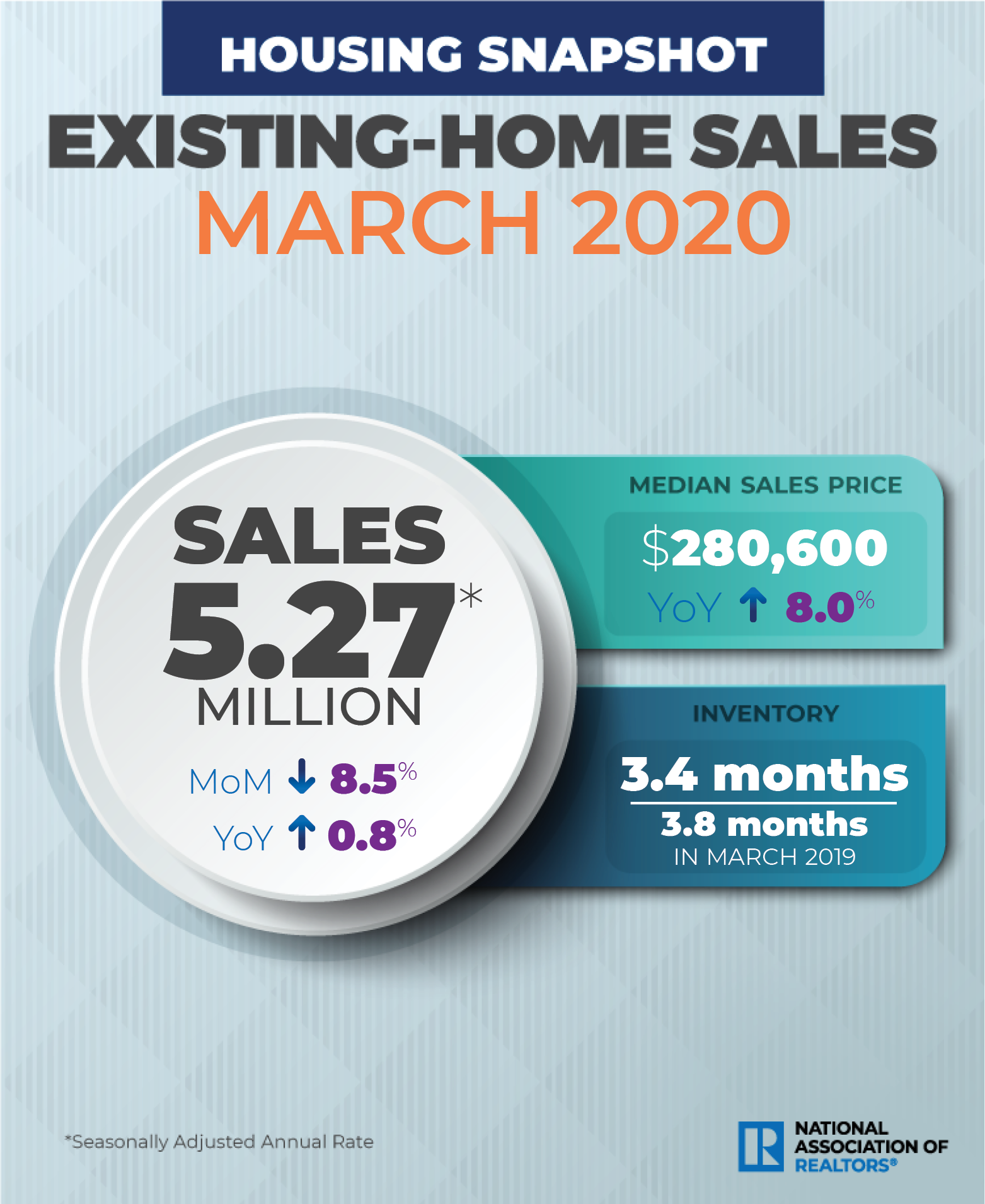The WPJ
THE WORLD PROPERTY JOURNALReal Estate Facts Not Fiction
Residential Real Estate News

Impacted by COVID-19, U.S. Home Sales in March See Biggest Sales Drop in Years
Residential News » Washington D.C. Edition | By Michael Gerrity | April 22, 2020 9:01 AM ET
Home Sales Could Decline Upto 40 Percent in the Coming Months, says NAR
According to the National Association of Realtors, existing-home sales in the U.S. fell in March 2020. Each of the four major regions reported a dip in sales, with the West suffering the largest decrease.
Total existing-home sales, which include completed transactions of single-family homes, townhomes, condominiums and co-ops, dropped 8.5% from February to a seasonally-adjusted annual rate of 5.27 million in March. Despite the decline, overall sales increased year-over-year for the ninth straight month, up 0.8% from a year ago (5.23 million in March 2019).

Lawrence Yun
While sales have declined, home prices are still solidly strong. The median existing-home price for all housing types in March was $280,600, up 8.0% from March 2019 ($259,700), as prices increased in every region. March's national price increase marks 97 straight months of year-over-year gains.
Total housing inventory at the end of March totaled 1.50 million units, up 2.7% from February, but down 10.2% from one year ago (1.67 million). Unsold inventory sits at a 3.4-month supply at the current sales pace, up from 3.0-months in February and down from the 3.8-month figure recorded in March 2019.
"Earlier in the year, we watched inventory gradually tick upward but with the current quarantine recommendations in place, fewer sellers are listing homes, which will limit buyer choices," Yun said. "Significantly more listings are needed and more will come on to the market once the economy steadily reopens."
NAR's most recent Flash Survey showed that 93% of sellers changed behavior to help the homebuying transaction move forward with social distancing and necessary precautions.
Properties typically remained on the market for 29 days in March, seasonally down from 36 days in February, and down from 36 days in March 2019. Fifty-two percent of homes sold in March 2020 were on the market for less than a month.
First-time buyers were responsible for 34% of sales in March, up from both 32% in February and 33% in March 2019. NAR's 2019 Profile of Home Buyers and Sellers - released in late 2019 -- revealed that the annual share of first-time buyers was 33%.
"Despite the social distancing restrictions, with many Realtors conducting virtual open home tours and with mortgage rates on the decline, a number of first-time buyers were still able to purchase housing last month," Yun said.
Individual investors or second-home buyers, who account for many cash sales, purchased 13% of homes in March, down from both 17% in February and 18% in March 2019. All-cash sales accounted for 19% of transactions in March, down from both 20% in February and 21% in March 2019.
Distressed sales -- foreclosures and short sales - represented 3% of sales in March, up from 2% in February, and unchanged from 3% in March 2019.
Realtor.com's Market Hotness Index, measuring time-on-the-market data and listing views per property, revealed that the hottest metro areas in March were Colorado Springs, Colo.; Modesto, Calif.; Manchester-Nashua, N.H.; Rochester, N.Y.; and Lafayette-West Lafayette, Ind.
According to Freddie Mac, the average commitment rate for a 30-year, conventional, fixed-rate mortgage decreased to 3.45% in March, down from 3.47% in February. The average commitment rate across all of 2019 was 3.94%.
Single-family and Condo/Co-op Sales
Single-family home sales sat at a seasonally-adjusted annual rate of 4.74 million in March, down from 5.16 million in February, and up 1.3% from a year ago. The median existing single-family home price was $282,500 in March, up 8.0% from March 2019.
Existing condominium and co-op sales were recorded at a seasonally adjusted annual rate of 530,000 units in March, down 11.7% from February and down 3.6% from a year ago. The median existing condo price was $263,400 in March, an increase of 7.9% from a year ago.
Regional Breakdown
Compared to the month prior, March sales decreased in every region, while the Midwest and the South experienced increases in year-over-year sales. Median home prices in all regions increased from one year ago, with the Northeast and Midwest regions showing the strongest price gains.
March 2020 existing-home sales in the Northeast fell 7.1%, recording an annual rate of 650,000, a 3.0% decrease from a year ago. The median price in the Northeast was $300,400, up 8.3% from March 2019.
Existing-home sales decreased 3.1% in the Midwest to an annual rate of 1.25 million, up 4.2% from a year ago. The median price in the Midwest was $219,700, a 9.7% increase from March 2019.
Existing-home sales in the South dropped 9.1% to an annual rate of 2.29 million in March, up 0.9% from the same time one year ago. The median price in the South was $245,100, a 7.5% increase from a year ago.
Existing-home sales in the West fell 13.6% to an annual rate of 1.08 million in March, a 0.9% decline from a year ago. The median price in the West was $420,600, up 8.0% from March 2019.

Sign Up Free | The WPJ Weekly Newsletter
Relevant real estate news.
Actionable market intelligence.
Right to your inbox every week.
Real Estate Listings Showcase
Related News Stories
Residential Real Estate Headlines
- U.S. New-Home Sales Surge in August as Mortgage Rates Ease
- Despite Increased Foreign Buyer Activity, Miami Residential Sales Dip 11 Percent in August
- California Home Sales Enjoy Modest Uptick as Mortgage Rates Ease
- U.S. Home-Flipping Profits Sink to Lowest Level Since 2008 Financial Crisis as Costs Climb
- Why the World's Rich Are Flocking to Europe in 2025
- Federal Reserve Delivers First Rate Cut of 2025 as Mortgage Relief Proves Limited
- Homebuilder Sentiment Holds Steady in U.S. as Rate-Cut Bets Lift Outlook
- U.S. Mortgage Rates Experience Sharpest Weekly Drop in Over a Year
- U.S. Foreclosures Rise for Sixth Straight Month as Affordability Pressures Mount
- Black U.S. Homeownership Rate Falls to Two-Year Low as Job Losses Mount
- Las Vegas Home Prices Flatten as Listings Surge, Sales Slow
- Cooling Miami Housing Market Sees 16 Percent Annual Sales Drop in July
- U.S. Mortgage Delinquencies Uptick in June Amid Regional Pressures
- California, Florida Top U.S. Housing Markets Most at Risk of Downturn
- 30-Year Mortgage Drops to 6.56 Percent in Late August, Lowest Since October 2024
- Investors Maintain Elevated Role in U.S. Housing Market Despite Slight Pullback
- Pending Home Sales Show Mixed Signals as U.S. Buyers Remain Cautious
- Canadian Home Sales Extend Recovery in July
- U.S. Home Sales Rise in July as Buyers Gain More Bargaining Power
- Zombie Foreclosures Edge Up Across U.S.
- 2.6 Million Homes at Wildfire Risk Across 14 Western States in 2025
- One in Five Americans Willing to Trade Personal Safety for Home Affordability
- U.S. Home Price Growth Slows as Affordability Pressures Mount in 2025
- U.S. Mortgage Rates Dip to Four Month Low in Early August
- U.S. Mortgage Applications Rise in Late July, Breaking Four-Week Slump
- Hong Kong's Housing Market Stuck in Stalemate as Bulls and Bears Face Off
- U.S. Condo Market Struggles in 2025
- U.S. Pending Home Sales Remain Sluggish in June
- Los Angeles Area Wildfires Destroyed Nearly $52 Billion in Homes Last January
- Greater Palm Beach Area Residential Sales Slip in June Amid Growing Inventory
- Economic Resilience Lifts U.S. Housing Outlook Going Forward
- New Home Sales Stagnate as Affordability Struggles Continue in America
- U.S. Housing Market Slips in June as Prices Hit New Highs
- Florida, California Continue to Reign Supreme as America's Ultraluxury Housing Markets
- Caribbean Housing Market Evolves into Global Second-Home Hotspot
- U.S. Home Sales See Highest June Cancellation Rate on Record
- Orlando Housing Market Cools in June as Listings Slide, Sales Slow
- Private Credit Surges in 2025 as Real Estate Developers Bypass Banks
- U.S. Condo Market Suffers Sharpest Price Drops in Over a Decade as Buyers Retreat
- Rising Taxes, Insurance Costs Undermine the Stability of U.S. Homeownership
Reader Poll
Marketplace Links
This website uses cookies to improve user experience. By using our website you consent in accordance with our Cookie Policy. Read More







